Yaoliang Song
Enhanced DOA Estimation via Hybrid Massive MIMO Receive Array with Switches-based Sparse Architecture
Sep 22, 2024


Abstract:Hybrid massive arrays have been widely used in direction of arrival (DOA) estimation for it can provide larger aperture with lower hardware complexity. However, as the signals received by a hybrid array are compressed by the phase shifter network or the switch network, the degree of freedom (DOF) or spatial resolution of hybrid array is lower than fully-digital (FD) array with same number of antennas. Therefore, we develop a novel sparse hybrid array called switches-based sparse hybrid array (SW-SHA) which by combining nested array and switches-based hybrid array to achieve a huge improvement on DOF over traditional hybrid arrays. Simulations of the spatial spectrums verify that SW-SHA can accurately solve the problem of DOA estimation with the number of signal sources much larger than the number of RF chains. Finally, to further improve the accuracy of DOA estimation for SW-SHA, MMV-SW-SHA is proposed by transforming the single-snapshot co-array signal into MMV form. The simulation results also show that MMV-SW-SHA has better performance than SW-SHA when signal-to-noise ratio (SNR) is low.
Machine learning-based Near-field Emitter Localization via Grouped Hybrid Analog and Digital Massive MIMO Receive Array
Jun 14, 2024



Abstract:A fully-digital massive MIMO receive array is promising to meet the high-resolution requirement of near-field (NF) emitter localization, but it also results in the significantly increasing of hardware costs and algorithm complexity. In order to meet the future demand for green communication while maintaining high performance, the grouped hybrid analog and digital (HAD) structure is proposed for NF DOA estimation, which divides the large-scale receive array into small-scale groups and each group contains several subarrays. Thus the NF direction-of-arrival (DOA) estimation problem is viewed as far-field (FF) within each group, and some existing methods such as MUSIC, Root-MUSIC, ESPRIT, etc., can be adopted. Then by angle calibration, a candidate position set is generated. To eliminate the phase ambiguity arising from the HAD structure and obtain the emitter position, two low-complexity clustering-based methods, minimum sample distance clustering (MSDC) and range scatter diagram (RSD) - angle scatter diagram (ASD)-based DBSCAN (RSD-ASD-DBSCAN), are proposed based on the distribution features of samples in the candidate position set. Then to further improve the localization accuracy, a model-driven regression network (RegNet) is designed, which consists of a multi-layer neural network (MLNN) for false solution elimination and a perceptron for angle fusion. Finally, the Cramer-Rao lower bound (CRLB) of NF emitter localization for the proposed grouped HAD structure is also derived. The simulation results show that the proposed methods can achieve CRLB at different SNR regions, the RegNet has great performance advantages at low SNR regions and the clustering-based methods have much lower complexity.
A Novel Tree Model-based DNN to Achieve a High-Resolution DOA Estimation via Massive MIMO receive array
Nov 30, 2023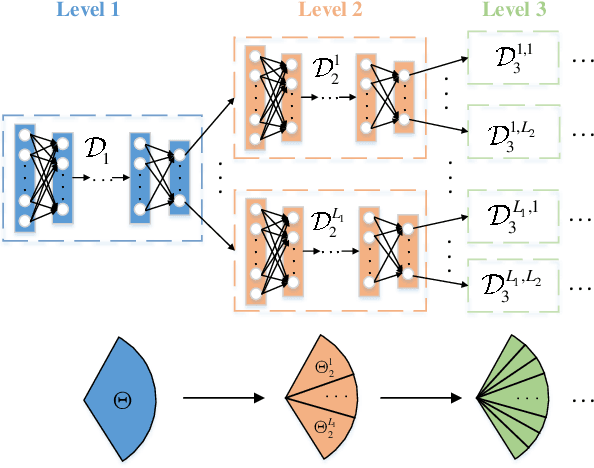
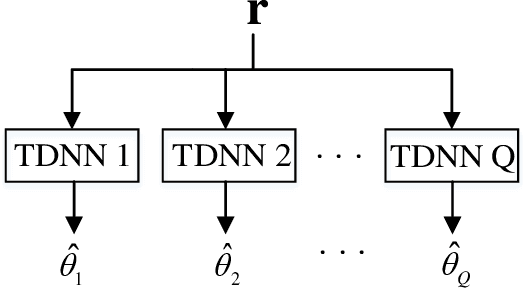
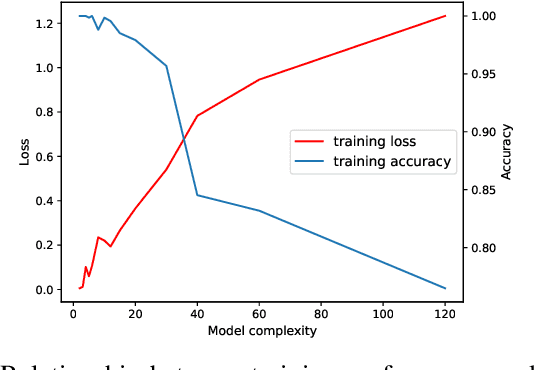
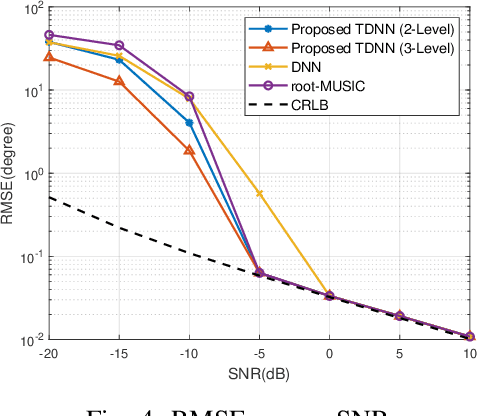
Abstract:To satisfy the high-resolution requirements of direction-of-arrival (DOA) estimation, conventional deep neural network (DNN)-based methods using grid idea need to significantly increase the number of output classifications and also produce a huge high model complexity. To address this problem, a multi-level tree-based DNN model (TDNN) is proposed as an alternative, where each level takes small-scale multi-layer neural networks (MLNNs) as nodes to divide the target angular interval into multiple sub-intervals, and each output class is associated to a MLNN at the next level. Then the number of MLNNs is gradually increasing from the first level to the last level, and so increasing the depth of tree will dramatically raise the number of output classes to improve the estimation accuracy. More importantly, this network is extended to make a multi-emitter DOA estimation. Simulation results show that the proposed TDNN performs much better than conventional DNN and root-MUSIC at extremely low signal-to-noise ratio (SNR), and can achieve Cramer-Rao lower bound (CRLB). Additionally, in the multi-emitter scenario, the proposed Q-TDNN has also made a substantial performance enhancement over DNN and Root-MUSIC, and this gain grows as the number of emitters increases.
Deep Learning Based DOA Estimation for Hybrid Massive MIMO Receive Array with Overlapped Subarrays
Sep 11, 2022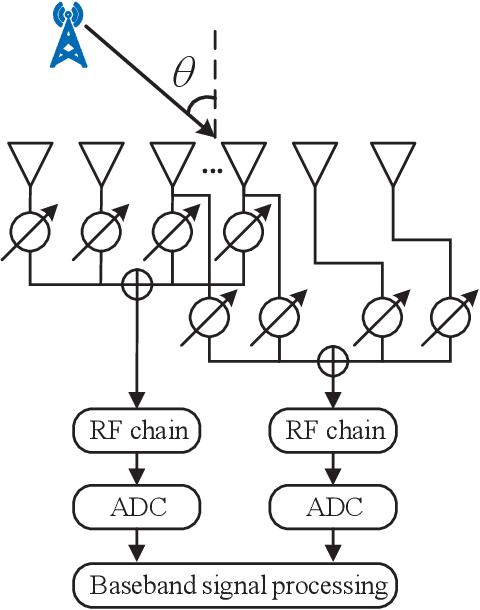

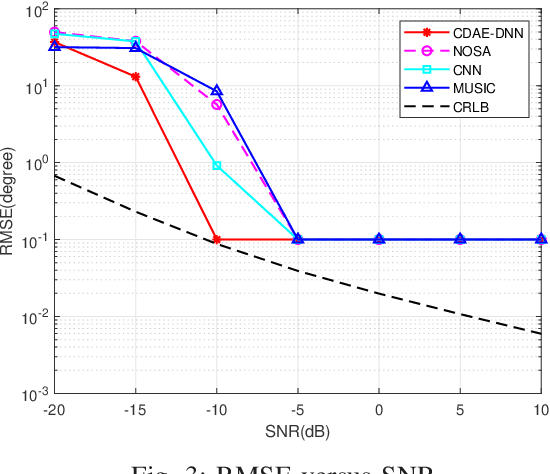
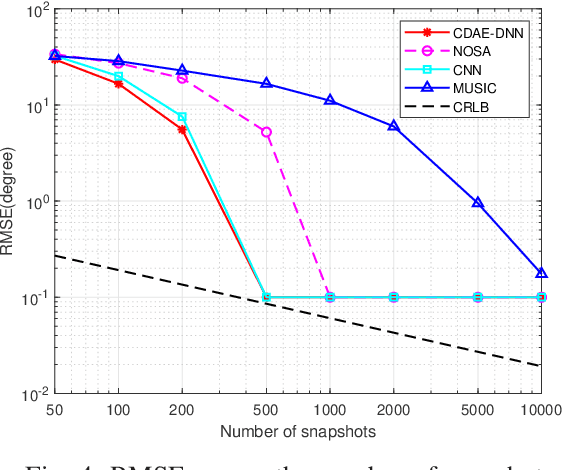
Abstract:To improve the accuracy of direction-of-arrival (DOA) estimation, a deep learning (DL)-based method called CDAE-DNN is proposed for hybrid analog and digital (HAD) massive MIMO receive array with overlapped subarray (OSA) architecture in this paper. In the proposed method, the sample covariance matrix (SCM) is first input to a convolution denoise autoencoder (CDAE) to remove the approximation error, then the output of CDAE is imported to a fully-connected (FC) network to get the estimation result. Based on the simulation results, the proposed CDAE-DNN has great performance advantages over traditional MUSIC algorithm and CNN-based method, especially in the situations with low signal to noise ratio (SNR) and low snapshot numbers. And the OSA architecture has also been shown to significantly improve the estimation accuracy compared to non-overlapped subarray (NOSA) architecture. In addition, the Cramer-Rao lower bound (CRLB) for the HAD-OSA architecture is presented.
Machine Learning Methods for Inferring the Number of Passive Emitters via Massive MIMO Receive Array
Mar 02, 2022
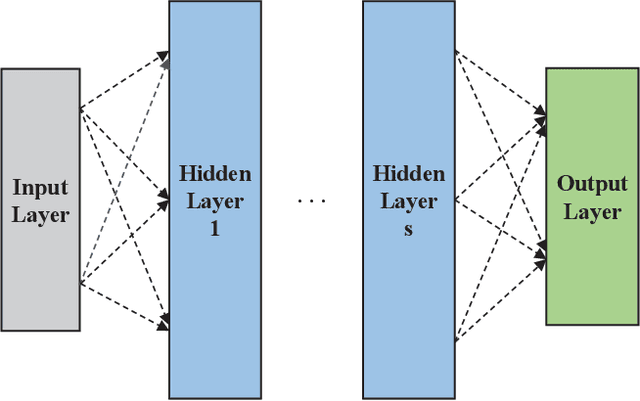

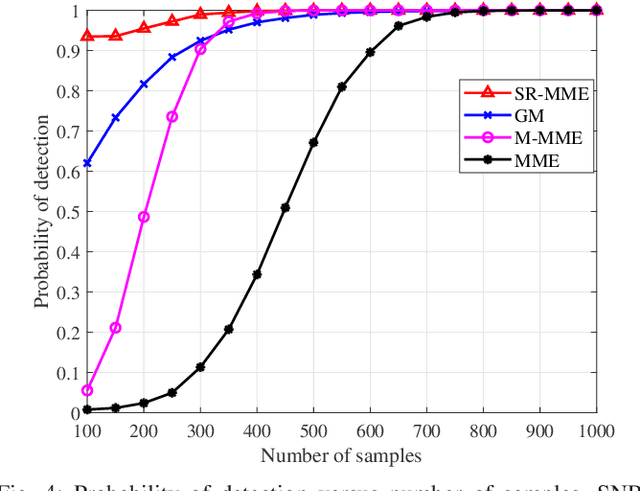
Abstract:To improve the efficiency and accuracy of direction finding with massive MIMO receive array, it is necessary to determine the specific number of signal emitters in advance. In this paper, we present a complete DOA preprocessing system for inferring the number of passive emitters. Firstly, in order to improve the accuracy of detecting the number of signals, two high-precision signal detectors, square root of maximum eigenvalue times minimum eigenvalue (SR-MME) and geometric mean (GM), are proposed. Compared to other detectors, SR-MME and GM can achieve a high detection probability while maintaining extremely low false alarm probability. Secondly, if the existence of emitters is determined by detectors, we need to further confirm their number, that is a problem of pattern classification. Therefore, we perform feature extraction on the the eigenvalue sequence of sample covariance matrix to construct feature vector and innovatively propose a multi-layer neural network (ML-NN). Additionally, the support vector machine (SVM), and naive Bayesian classifier (NBC) are also designed. The simulation results show that the machine learning-based methods can achieve good results in signal classification, especially neural networks, which can always maintain the classification accuracy above 70\% with massive MIMO receive array. Finally, we analyze the classical signal classification methods, Akaike (AIC) and Minimum description length (MDL). It is concluded that the two methods are not suitable for scenarios with massive receive arrays, and they also have much worse performance than machine learning-based classifiers.
 Add to Chrome
Add to Chrome Add to Firefox
Add to Firefox Add to Edge
Add to Edge